American robin
| American robin | |
|---|---|
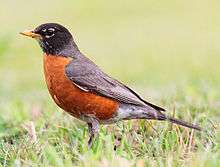 | |
| Male | |
| Scientific classification | |
| Kingdom: | Animalia |
| Phylum: | Chordata |
| Class: | Aves |
| Order: | Passeriformes |
| Family: | Turdidae |
| Genus: | Turdus |
| Species: | T. migratorius |
| Binomial name | |
| Turdus migratorius Linnaeus, 1766 | |
 | |
| Breeding range Year-round range Wintering range | |
| Synonyms | |
|
Merula migratoria | |
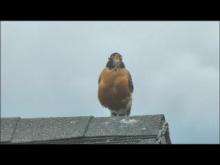
The American robin (Turdus migratorius) is a migratory songbird of the thrush family. It is named after the European robin[2] because of its reddish-orange breast, though the two species are not closely related, with the European robin belonging to the Old World flycatcher family. The American robin is widely distributed throughout North America, wintering from southern Canada to central Mexico and along the Pacific Coast. It is the state bird of Connecticut, Michigan, and Wisconsin.[3] According to some sources, the American robin ranks behind only the red-winged blackbird (and just ahead of the introduced European starling and the not-always-naturally-occurring house finch) as the most abundant extant land bird in North America.[4] It has seven subspecies, but only T. m. confinis of Baja California Sur is particularly distinctive, with pale gray-brown underparts.
The American robin is active mostly during the day and assembles in large flocks at night. Its diet consists of invertebrates (such as beetle grubs, earthworms, and caterpillars), fruits, and berries. It is one of the earliest bird species to lay eggs, beginning to breed shortly after returning to its summer range from its winter range. Its nest consists of long coarse grass, twigs, paper, and feathers, and is smeared with mud and often cushioned with grass or other soft materials. It is among the first birds to sing at dawn, and its song consists of several discrete units that are repeated.
The adult robin is preyed upon by hawks, cats, and larger snakes, but when feeding in flocks, it can be vigilant and watch other birds for reactions to predators. Brown-headed cowbirds lay eggs in robin nests (see brood parasite), but robins usually reject the cowbird eggs.
Taxonomy
This species was first described in 1766 by Carl Linnaeus in the twelfth edition of his Systema Naturae as Turdus migratorius.[5] The binomial name derives from two Latin words: turdus, "thrush", and migratorius from migrare "to go". The term robin for this species has been recorded since at least 1703.[6] There are about 65 species of medium to large thrushes in the genus Turdus, characterized by rounded heads, longish pointed wings, and usually melodious songs.[7] A study of the mitochondrial cytochrome b gene indicates that the American robin is not part of the Central/South American clade of Turdus thrushes; instead it shows genetic similarities to the Kurrichane thrush, T. libonyanus, and the olive thrush, T. olivaceus, both African species.[8][9] This conflicts with a 2007 DNA study of 60 of 65 Turdus species which places the American robin's closest relative as the rufous-collared robin (T. rufitorques) of Central America. Though having distinct plumage, the two species are similar in vocalization and behavior. Beyond this, it lies in a small group of four species of otherwise Central American distribution, suggesting it recently spread northwards into North America.[10]
Seven subspecies of American robin are recognized. These subspecies intergrade and are only weakly defined.[7]
- T. m. migratorius, the nominate subspecies, breeds in the US and Canada, other than down the west coast, to the edge of the tundra from Alaska and northern Canada east to New England and then south to Maryland, northwest Virginia, and North Carolina. It winters in southern coastal Alaska, southern Canada, most of the US, Bermuda, the Bahamas and eastern Mexico.[7]
- T. m. nigrideus breeds from coastal northern Quebec to Labrador and Newfoundland and winters from southern Newfoundland south through most of the eastern US states to southern Louisiana, southern Mississippi and northern Georgia. It is uniformly darker or blackish on the head, with a dark gray back. The underparts are slightly more red than those of the nominate subspecies.[7]
- T. m. achrusterus breeds from southern Oklahoma east to Maryland and western Virginia and south to northern Florida and the Gulf states. It winters through much of the southern part of the breeding range. It is smaller than the nominate subspecies. The black feathers of the forehead and crown have pale gray tips. The underparts are paler than those of the nominate subspecies.[7]
- T. m. caurinus breeds in southeast Alaska through coastal British Columbia to Washington and northwest Oregon. It winters from southwest British Columbia south to central and southern California and east to northern Idaho. It is very slightly smaller than the nominate subspecies and very dark-headed. The white on the tips of the outer two tail feathers is restricted.[7]
- T. m. propinquus breeds from southeast British Columbia, southern Alberta, southwest Saskatchewan south to southern California and northern Baja California. It winters throughout much of the southern breeding range and south to Baja California. It is the same size as or slightly larger than nominate T. m. migratorius, but paler and tinged more heavily brownish-gray. It has very little white on the tip of the outermost tail feather. Some birds, probably females, lack almost any red below. Males are usually darker and may show pale or whitish sides to the head.[7]
- T. m. confinis breeds above 1,000 m (3,300 ft) in the highlands of southern Baja California. This form is particularly distinctive, with pale gray-brown underparts. It is relatively small, and the palest subspecies, with uniform pale gray-brown on the head, face and upperparts. It usually lacks any white spots to the tips of the outer tail feathers, which have white edges. It is sometimes classed as a separate species, the San Lucas robin,[7] but the American Ornithologists' Union regards it as only a subspecies, albeit in a different group from the other races.[11]
- T. m. phillipsi is resident in Mexico south to central Oaxaca. It is slightly smaller than propinquus but has a larger bill; the male's underparts are less brick-red than the nominate subspecies, and have a rustier tone.[7]
Description
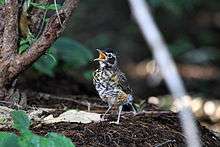
.jpg)
The nominate subspecies of the American robin is 23 to 28 cm (9.1 to 11.0 in) long with a wingspan ranging from 31 to 41 cm (12 to 16 in), with similar size ranges across all races. The species averages about 77 g (2.7 oz) in weight, with males ranging from 72 to 94 g (2.5 to 3.3 oz) and females ranging from 59 to 91 g (2.1 to 3.2 oz).[12][13] Among standard measurements, the wing chord is 11.5 to 14.5 cm (4.5 to 5.7 in), the culmen is 1.8 to 2.2 cm (0.71 to 0.87 in) and the tarsus is 2.9 to 3.3 cm (1.1 to 1.3 in).[14] The head varies from jet black to gray, with white eye arcs and white supercilia.[15] The throat is white with black streaks, and the belly and undertail coverts are white. The robin has a brown back and a reddish-orange breast, varying from a rich red maroon to peachy orange.[12] The bill is mainly yellow with a variably dark tip, the dusky area becoming more extensive in winter, and the legs and feet are brown.[15]
The sexes are similar, but the female tends to be duller than the male, with a brown tint to the head, brown upperparts and less bright underparts. However, some birds cannot be safely sexed on plumage alone.[7] The juvenile is paler in color than the adult male and has dark spots on its breast,[12] and whitish wing coverts.[15] First-year birds are not easily distinguishable from adults, but they tend to be duller, and a small percentage retains a few juvenile wing coverts or other feathers.[15]
Distribution and habitat
This bird breeds throughout most of North America, from Alaska and Canada southward to northern Florida and Mexico.[16] While robins occasionally overwinter in the northern part of the United States and southern Canada,[12] most migrate to winter south of Canada from Florida and the Gulf Coast to central Mexico, as well as along the Pacific Coast.[16] Most depart south by the end of August and begin to return north in February and March (exact dates vary with latitude and climate). Despite being depicted in the film Mary Poppins "feathering its nest" in London,[17] this species is actually a rare vagrant to western Europe, where the majority of records, more than 20, have been in Britain.[7] In autumn 2003, migration was displaced eastwards leading to massive movements through the eastern U.S., and presumably this is what led to no fewer than three American robins being found in Britain, with two attempting to overwinter in 2003–2004,[18] although one was taken by a sparrowhawk.[19][20] The most recent sighting in Britain occurred in January 2007.[21]
This species has also occurred as a vagrant to Greenland, Jamaica, Hispaniola, Puerto Rico and Belize. Vagrants to Europe, where identified to subspecies, are nominate T. m. migratorius, but the Greenland birds also included T. m. nigrideus, and some of the southern overshots may have been T. m. achrusterus.[7]
The American robin's breeding habitat is woodland and more open farmland and urban areas. It becomes less common as a breeder in the southernmost part of the Deep South of the United States, and there prefers large shade trees on lawns.[22] Its winter habitat is similar but includes more open areas.[7]
Conservation status
The American robin has an extensive range, estimated at 16,000,000 km2 (6,200,000 sq mi), and a large population of about 320 million individuals. The species is not believed to approach the thresholds for the population decline criterion of the IUCN Red List (i.e., declining more than 30% in ten years or three generations), and is therefore evaluated as least concern.[1] At one point, the bird was killed for its meat, but it is now protected throughout its range in the United States by the Migratory Bird Act.[12]
Birds in central California of the subspecies propinquus are considered to be still increasing their range, and this is probably the case elsewhere in the U.S.A.[7]
Disease
The American robin is a known reservoir (carrier) for West Nile virus. While crows and jays are often the first noticed deaths in an area with West Nile virus, the American robin is suspected to be a key host, and holds a larger responsibility for the transmission of the virus to humans. This is because, while crows and jays die quickly from the virus, the American robin survives the virus longer, hence spreading it to more mosquitoes, which then transmit the virus to humans and other species.[23][24]
Behavior
The American robin is active mostly during the day, and on its winter grounds it assembles in large flocks at night to roost in trees in secluded swamps or dense vegetation. The flocks break up during the day when the birds feed on fruits and berries in smaller groups. During the summer, the American robin defends a breeding territory and is less social.[12]
Diet


The American robin's diet generally consists of around 40 percent small invertebrates (mainly insects), such as earthworms, beetle grubs, caterpillars and grasshoppers, and 60 percent wild and cultivated fruits and berries.[12] Their ability to switch to berries allows them to winter much farther north than most other North American thrushes. They will flock to fermented Pyracantha berries, and after eating sufficient quantities will exhibit intoxicated behavior such as falling over while walking. Robins forage primarily on the ground for soft-bodied invertebrates, and find worms by sight, pouncing on them and then pulling them up.[16] Nestlings are fed mainly on worms and other soft-bodied animal prey. In some areas, robins, particularly of the coastal race T. m. caurinus, will feed on beaches, taking insects and small mollusks.[7]
The robin uses auditory, visual, olfactory and possibly vibrotactile cues to find prey, but vision is the predominant mode of prey detection.[25] It is frequently seen running across lawns picking up earthworms, and its running and stopping behavior is a distinguishing characteristic. In addition to hunting visually, it also has the ability to hunt by hearing. Experiments have discovered that it can find worms underground by simply using its listening skills.[25]:149 It typically will take several short hops and then cock its head left, right or forward to detect movement of its prey. In urban areas, robins will gather in numbers soon after lawns are mowed or where sprinklers are in use.[16] They also are attracted to freshly turned earth in gardens, where worms and grubs are abundant targets. Occasionally, they may visit bird feeders if mealworms or animal-fat suet is offered.
Threats
Juvenile robins and eggs are preyed upon by squirrels, snakes, and some birds, such as blue jays, Steller's jay, common grackles, American crows, and common ravens.[12] Adults are primarily taken by Accipiter hawks, cats, dogs, and larger snakes (especially rat snakes).[26] They may be taken by nearly every variety of North American accipitrid, from the smallest, the sharp-shinned hawk, to one of the two largest, the golden eagle, most every North American falcon from the smallest, the American kestrel, to the largest, the gyrfalcon, and almost all owl species from northern pygmy owls to snowy owls. Overall, 28 raptorial bird species are known to hunt robins.[27][28][29][30][31][32] Adult robins are most vulnerable when distracted by breeding activities though may also be attacked on the ground or even in flight. However, when feeding in flocks, the American robin is able to remain vigilant and watch other flock members for reactions to predators.[12]
The American robin is known to be a rejecter of cowbird eggs, so brood parasitism by the brown-headed cowbird is rare. Even when it occurs, the parasite's chick does not normally survive to fledging.[33] In a study of 105 juvenile robins, 77.1% were infected with one or more species of endoparasite, with Syngamus species the most commonly encountered, found in 57.1% of the birds.[34]
Breeding
The American robin begins to breed shortly after returning to its summer range. It is one of the first North American bird species to lay eggs, and normally has two to three broods per breeding season, which lasts from April to July.[12]
The nest is most commonly located 1.5–4.5 m (4.9–14.8 ft) above the ground in a dense bush or in a fork between two tree branches, and is built by the female alone. The outer foundation consists of long coarse grass, twigs, paper, and feathers. This is lined with smeared mud and cushioned with fine grass or other soft materials. A new nest is built for each brood, and in northern areas the first clutch is usually placed in an evergreen tree or shrub while later broods are placed in deciduous trees.[12] The American robin does not shy away from nesting close to human habitation[35] and will frequently construct nests under eaves or awnings on human homes when such locations provide adequate shelter. Robins are not cavity nesters, and so will generally not use a bird house, but will take advantage of artificial nesting platforms that have been provided.
A clutch consists of three to five light blue eggs, and is incubated by the female alone. The eggs hatch after 14 days, and the chicks leave the nest a further two weeks later. The altricial chicks are naked and have their eyes closed for the first few days after hatching.[36] While the chicks are still young, the mother broods them continuously. When they are older, the mother will brood them only at night or during bad weather.
The chicks are fed worms, insects, and berries. Waste accumulation does not occur in the nest because adults collect and take it away. Chicks are fed, and then raise tails for elimination of waste, a solid white clump that is collected by a parent prior to flying off. All chicks in the brood leave the nest within two days of each other.[12] Even after leaving the nest, the juveniles will follow their parents around and beg food from them. Juveniles become capable of sustained flight two weeks after fledging.[12]
The adult male and female both are active in protecting and feeding the fledged chicks until they learn to forage on their own. The adult robin gives alarm calls and dives in a threatening manner towards creatures it considers potential predators, such as approaching cats, dogs and humans. The fledglings are able to fly short distances after leaving the nest. The wings of juvenile birds develop rapidly, and it only takes a couple of weeks for them to become proficient at flying. The cryptically colored young birds perch in bushes or trees for protection from predators.
Bird banders have found that only 25% of young robins survive the first year.[12] The longest known lifespan in the wild of an American robin is 14 years; the average lifespan is about 2 years.[12]
-
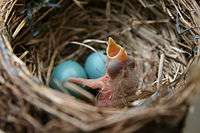
Newly hatched chick among unhatched young
-
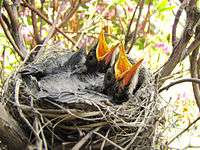
Chicks
-
Eggs, Collection Museum Wiesbaden
-

Nest amidst human habitat
-
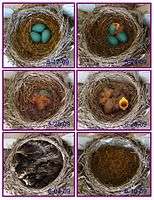
Sequence of dated images showing the progress from eggs to flight in three weeks
-
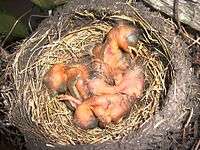
Newly hatched chicks
-

Chick
-
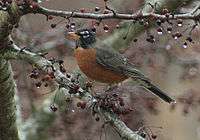
American robin in Rhode Island
Vocalization
 |
American Robin
Dawn song of the American robin, with a chickadee heard faintly in the background. |
| Problems playing this file? See media help. | |
The male American robin, as with many thrushes, has a complex and almost continuous song. Its song is commonly described as a cheerily carol, made up of discrete units, often repeated, and spliced together into a string with brief pauses in between.[22] The song varies regionally, and its style varies by time of day. The song period is from early March in California to late July or early August; some birds, particularly in the east, sing occasionally into September or later. The American robin is often among the first songbirds singing as dawn rises or hours before, and last as evening sets in. It usually sings from a high perch in a tree.[12] The song of T. m. confinis is weaker than that of the nominate subspecies, and lacks any clear notes.[7]
The robin also sings when storms approach and again when storms have passed.[37] In addition to its song, the American robin has a number of calls used for communicating specific information such as when a ground predator approaches, and when a nest or robin is being directly threatened. Even during nesting season, when robins exhibit mostly competitive and territorial behavior, they may still band together to drive away a predator.[7]
In culture
The American robin is the state bird of Connecticut, Michigan, and Wisconsin.[3] It was also depicted on the 1986 Birds of Canada series Canadian $2 note, but this note has since been withdrawn.[38][39]
Robin's egg blue is a color named after the bird's eggs.[6]
The American robin has a place in Native American mythology. The story of how the robin got its red breast by fanning the dying flames of a campfire to save a Native American man and a boy is similar to those that surround the European robin.[40] The Tlingit people of Northwestern North America held it to be a culture-hero created by Raven to please the people with its song.[41] One of the houses of the Raven Tribe from the Nisga'a Nation holds the robin as a house crest.
The Peace Bridge robins were a family of American robins that attracted minor publicity in the mid-1930s for their prominent nest on the Canadian side of the Peace Bridge connecting Buffalo, New York to Fort Erie, Ontario.[42]
The robin is considered a symbol of spring.[43] A well-known example is a poem by Emily Dickinson, "I Dreaded That First Robin So". Among other 19th-century poems about the first robin of spring is "The First Robin" by Dr. William H. Drummond, which according to the author's wife is based on a Quebec superstition that whoever sees the first robin of spring will have good luck.[44] The harbinger of spring sobriquet is borne out by the fact that robins tend to follow the 37 °F (3 °C) isotherm north in spring, but also south in fall.[45]
American popular songs featuring this bird include "When the Red, Red Robin (Comes Bob, Bob, Bobbin' Along)", written by Harry M. Woods[46] and a hit for Al Jolson and others, and "Rockin' Robin", written by Roger Thomas and a hit for Bobby Day and others.
Although the comic-book superhero Robin was inspired by an N. C. Wyeth illustration of Robin Hood,[47][48] a later version had his mother nicknaming him Robin because he was born on the first day of spring.[49] His red shirt suggests the bird's red breast.
See also
- Australasian robins of genus Petroica
References
- 1 2 BirdLife International (2012). "Turdus migratorius". IUCN Red List of Threatened Species. Version 2013.2. International Union for Conservation of Nature. Retrieved 26 November 2013.
- ↑ McCrum, Robert; Cran, William; MacNeil, Robert (1992). The Story of English. Faber and Faber. p. 123. ISBN 0-571-16443-9.
- 1 2 50 States. "Official US State Birds". Retrieved 25 July 2007.
- ↑ McWilliams, Gerald M. & Brauning, Daniel W., The Birds of Pennsylvania. Comstock Publishing Associates (2000), ISBN 0801436435.
- ↑ Linnaeus, C (1766). Systema naturae per regna tria naturae, secundum classes, ordines, genera, species, cum characteribus, differentiis, synonymis, locis. Tomus I. Editio duodecima, reformata. (in Latin). Holmiae. (Laurentii Salvii). p. 292.
- 1 2 Simpson, J.; Weiner, E., eds. (1989). "Robin". Oxford English Dictionary (2nd ed.). Oxford: Clarendon Press. ISBN 0-19-861186-2.
- 1 2 3 4 5 6 7 8 9 10 11 12 13 14 15 16 17 Clement, Peter; Hathway, Ren; Wilczur, Jan (2000). Thrushes (Helm Identification Guides). Christopher Helm Publishers Ltd. ISBN 0-7136-3940-7.
- ↑ Qiao-Wa Pan; Fu-Min Lei; Zuo-Hua Yin; Anton Kristin; Peter Kaņuch (2007). "Phylogenetic relationships between Turdus species: Mitochondrial cytochrome b gene analysis" (PDF). Ornis Fennica. 84: 1–11.
- ↑ Klicka, John; Voelker, Gary; Spellman, Garth M. (2005). "A molecular phylogenetic analysis of the "true thrushes" (Aves: Turdinae)" (PDF). Molecular Phylogenetics and Evolution. 34 (3): 486–500. doi:10.1016/j.ympev.2004.10.001. PMID 15683924.
- ↑ Voelker G, Rohwer S, Bowie RC, Outlaw DC (2007). "Molecular systematics of a speciose,cosmopolitan songbird genus: Defining the limits of, and relationships among, the Turdus thrushes". Molecular Phylogenetics and Evolution. 42 (2): 422–34. doi:10.1016/j.ympev.2006.07.016. PMID 16971142.
- ↑ "The A.O.U. Check-list of North American Birds" (PDF) (Seventh ed.). AOU. Archived (PDF) from the original on 10 February 2008. Retrieved 20 January 2008.
- 1 2 3 4 5 6 7 8 9 10 11 12 13 14 15 16 Dewey, Tanya; Middleton, Candice (2002). "Turdus migratorius". Animal Diversity Web. University of Michigan Museum of Zoology. Archived from the original on 24 November 2007. Retrieved 19 November 2007.
- ↑ American robin videos, photos and facts – Turdus migratorius. ARKive. Retrieved on 23 August 2012.
- ↑ Clement, Peter (2001) Thrushes. Princeton University Press. ISBN 978-0691088525.
- 1 2 3 4 Leukering, T. (2006). Alderfer, John, ed. Complete Birds of North America. Washington, D.C.: National Geographic Society. p. 492. ISBN 0-7922-4175-4.
- 1 2 3 4 Cornell Laboratory of Ornithology. "American Robin". Archived from the original on 9 June 2007. Retrieved 26 June 2007.
- ↑ "Mary Poppins (1964)". IMDb. Archived from the original on 1 January 2008. Retrieved 21 January 2008.
- ↑ Rogers, Michael J.; The Rarities Committee (December 2004). "Report on rare birds in Great Britain in 2004". British Birds. 98 (12): 628–694.
- ↑ "Twitchers watch robin served rare". BBC. 9 March 2004. Retrieved 20 January 2008.
- ↑ "Review of the Week 18th–31st December 2003". BirdGuides. Retrieved 20 January 2008.
- ↑ Roberts, John (26 January 2007) "Village braced for invasion of twitchers as rare visitor flies in", Yorkshire Post.
- 1 2 Bull J; Farrand, J Jr (1987). Audubon Society Field Guide to North American Birds:Eastern Region. New York: Alfred A. Knopf. p. 469. ISBN 0-394-41405-5.
- ↑ National Science Foundation: West Nile Virus: The Search for Answers in Chicago’s Suburbs
- ↑ Diversity Of Birds Buffer Against West Nile Virus. Sciencedaily.com (6 March 2009). Retrieved on 2012-08-23.
- 1 2 Montgomerie, Robert; Weatherhead, Patrick J. (1997). "How robins find worms" (PDF). Animal Behaviour. 54 (1): 143–151. doi:10.1006/anbe.1996.0411. PMID 9268444.
- ↑ Cox, T. M. (1986). "More on the bird-eating activities of the black rat snake, Elaphe obsoleta obsoleta (Say)". North. Ohio Assoc. Herpetol. Notes. 14: 18–19.
- ↑ Storer, R. W. (1966). "Sexual dimorphism and food habits in three North American accipiters". The Auk. 83 (3): 423–436. doi:10.2307/4083053. JSTOR 4083053.
- ↑ Olendorff, Richard R. (1976). "The Food Habits of North American Golden Eagles". American Midland Naturalist. 95 (1): 231–236. doi:10.2307/2424254. JSTOR 2424254.
- ↑ Bent, A. C. (1938). Life histories of North American birds of prey, pt. 2. U.S. Natl. Mus. Bull. no. 170.
- ↑ McCaffery, B. J., Booms, T. L., Doolittle, T. C., Broerman, F. R. E. D., Morgart, J. R., & Sowl, K. M. (2011). "The ecology of Gyrfalcons Falco rusticolus on the Yukon-Kuskokwim Delta, Alaska" in Gyrfalcons and Ptarmigan in a Changing World. The Peregrine Fund, Boise, Idaho, USA. ISBN 978-1461129073.
- ↑ Holt, D. W. & Leroux, L. A. (1996). "Diets of northern pygmy-owls and northern saw-whet owls in west-central Montana" (PDF). The Wilson Bulletin. 108 (1): 123–128.
- ↑ Campbell, R. W. & MacColl, M. D. (1978). "Winter foods of snowy owls in Southwestern British Columbia". The Journal of Wildlife Management. 42 (1): 190–192. doi:10.2307/3800714.
- ↑ Wolfe, Donald H. (December 1994). "Brown-headed Cowbirds fledged from Barn Swallow and American Robin nests". The Wilson Bulletin. 106 (4): 764–766. JSTOR 4163497.
- ↑ Welte, S. C.; Kirkpatrick, C. E. (1986). "Syngamiasis in juvenile American Robins (Turdus migratorius), with a note on the prevalence of other fecal parasites". Avian Diseases. 30 (4): 736–9. doi:10.2307/1590578. JSTOR 1590578. PMID 2949729.
- ↑ "Backyard Birding Information – How to Attract Robins". The Ornate Bird Garden. Archived from the original on 1 December 2007. Retrieved 27 November 2007.
- ↑ "American Robin (Turdus migratorius)". International Wildlife Rehabilitation Council. Retrieved 21 January 2008.
- ↑ Bergstrom, Jan (5 April 2014) Robins' return is familiar sight during spring. SCTimes.
- ↑ Canadian Paper Money Society. "Canadian Paper Money". Archived from the original on 3 January 2008. Retrieved 18 January 2008.
- ↑ Bank of Canada. "1986 Birds of Canada Series". Archived from the original on 27 October 2007. Retrieved 18 January 2008.
- ↑ Fox, Florence C. (1906). The Indian Primer (Fox's Indian Primer). American Book Company. pp. 88–95. Retrieved 22 May 2011.
- ↑ Cooper, JC (1992). Symbolic and Mythological Animals. London: Aquarian Press. p. 194. ISBN 1-85538-118-4.
- ↑ The Canadian Press. "Famous robins return to nest at Peace Bridge", The New York Times. 12 April 1936. Page 6.
- ↑ Durant, Alan; Fabb, Nigel (1990). Literary Studies in Action. Routledge. p. 75. ISBN 978-0-415-02945-2. Retrieved 1 February 2008.
- ↑ Drummond, William Henry (1908). The Great Fight. Preface by May Harvey Drummond. G. P. Putnam's Sons. pp. xi, 81–86. Retrieved 1 February 2008.
- ↑ McPhaul, Meghan McCarthy (May 11, 2016). "Robins don't necessarily mean spring". The Chronicle. Barton, Vermont. pp. 9A.
- ↑ "Cover of sheet music for "When the Red, Red Robin Comes Bob, Bob, Bobbing Along" – Ruth Etting". The Ruth Etting Web Site. 2007 [1997]. Retrieved 15 April 2012.
- ↑ Groth, Gary (15 October 2005). "Jerry Robinson". The Comics Journal (271). Archived from the original on 11 January 2008. Retrieved 7 February 2008.
I had a vision of Robin Hood just as Wyeth drew him in his costume, and that's what I quickly sketched out when I suggested [the name] Robin, which they seemed to like, and then showed them the costume.
- ↑ Ringgenberg, Steven (13 December 2011). "Jerry Robinson: January 1st, 1922 – December 7th, 2011". tcj.com. Retrieved 18 April 2013.
Robinson added much to the luster of the Batman legend, including coming up with the name Robin the Boy Wonder (inspired by Robin Hood), and designing his costume (inspired by the N.C. Wyeth painting Robin Meets Maid Marian).
- ↑ Bridwell, E. Nelson (w), Andru, Ross (p), Esposito, Mike (i). "The Origin of Robin" Batman 213 (July–August 1969), DC Comics
External links
| Wikimedia Commons has media related to Turdus migratorius. |
| Wikispecies has information related to: Turdus migratorius |
| Look up American robin in Wiktionary, the free dictionary. |
| Wikisource has the text of a 1921 Collier's Encyclopedia article about American robin. |
- FieldGuide – eNature.com
- "Robins of a Different Feather" – albinism in robins
- Animal Facts – natural history, maps, and photos at the Washington Nature Mapping Program
- Vocalizations – Journey North
- "American robin media". Internet Bird Collection.
- Sound file – vivanatura.org
- Plans for nesting shelves – Journey North
- Nesting journal – Photo blog following the process from nest building to leaving the nest – Webster's Wobbins
- Florida bird sounds including the American robin – Florida Museum of Natural History
- American robin subspecies Turdus migratorius nigrideus (Aldrich and Nutt)
- American robin growth progress with date stamp
- American robin photo gallery at VIREO (Drexel University)
